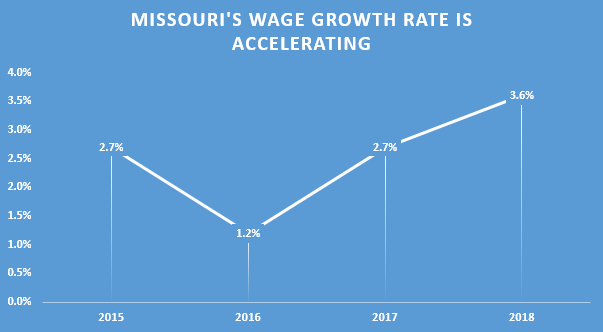Missouri saw wages increase in 2018 while unemployment rates remained steady and near an all-time low, new data showed.
According to the Quarterly Census of Employment and Wages (QCEW), a cooperative program between the U.S. Bureau of Labor Statistics and the Missouri Department of Economic Development, Missouri’s statewide annual average wage reached an all-time high of $49,050 in 2018 — a 3.6 percent increase over 2017 and a 10.6 percent increase over 2014.
Several Missouri counties saw particularly high average wage increases in 2018: Newton County, home to Neosho and metro Joplin, with a 13.7 percent increase; St. Louis County at a 5.2 percent increase; St. Louis City increased by 4.2 percent; and Webster County, home to Marshfield and metro Springfield, with a 4.4 percent increase.
Additionally, 74 percent of Missouri’s 114 counties had an annual average wage increase of more than 2 percent in 2018. Only three counties have seen wage decreases since 2014.
St. Louis City and County each had an annual average wage of over $60,500 in 2018. Jackson County, home to Kansas City and Independence, reached an annual average wage of $56,500.
At the same time, the unemployment rate has remained steady and low. For 34 consecutive months, Missouri’s unemployment rate has been lower than the corresponding U.S. rate. In November 2018, Missouri’s unemployment rate decreased to 3.0 percent, the lowest in the state’s historical data series dating back to 1976.
May’s unemployment rate was 3.3 percent — the same as in March and April. Out of the roughly 3 million individuals in Missouri’s civilian labor force, an estimated 101,321 were unemployed in May.
Missouri nonfarm payroll employment increased by 2,500 jobs over the month. Over the past year, employment has grown by 31,000 jobs.
Missouri continues to see over-the-year job gains across several industries: accommodation and food services up 4 percent (10,400 jobs); manufacturing up 2.8 percent (7,600 jobs); health care and social assistance up 2.6 percent (10,800 jobs); and professional, scientific and technical services up 2.6 percent (4,200 jobs).
To view the May 2019 jobs report, click here. A full breakdown of QCEW data can be found here.

Alisha Shurr was a reporter for The Missouri Times and The Missouri Times Magazine. She joined The Missouri Times in January 2018 after working as a copy editor for her hometown newspaper in Southern Oregon. Alisha is a graduate of Kansas State University.








